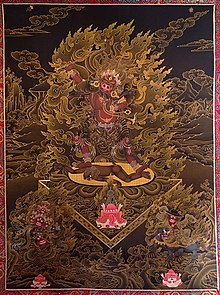
| Part of a series on |
| Tibetan Buddhism |
|---|
 |
Ekajaṭī or Ekajaṭā (Sanskrit: "One Plait Woman"; Wylie: ral gcig ma: one who has one knot of hair),[1] also known as Māhacīnatārā,[2] is one of the 21 Taras. Ekajati is one of the most powerful and fierce protectors of Vajrayana Buddhist mythology.[1][3] According to Tibetan legends[citation needed], her right eye was pierced by the tantric master Padmasambhava so that she could much more effectively help him subjugate Tibetan demons.
Ekajati is also known as "Blue Tārā", "Black Tārā", "Vajra Tārā" or "Ugra Tārā".[1][3] She is generally considered one of the three principal protectors of the Nyingma school along with Rāhula and Vajrasādhu (Wylie: rdo rje legs pa).
Often Ekajati appears as liberator in the mandala of the Green Tara. Along with that, her ascribed powers are removing the fear of enemies, spreading joy, and removing personal hindrances on the path to enlightenment.
Ekajati is the protector of secret mantras and "as the mother of all" represents the ultimate unity. As such, her own mantra is also secret. She is the most important protector of the Vajrayana teachings, especially the Inner Tantras and termas. As the protector of mantra, she supports the practitioner in deciphering symbolic dakini codes and properly determines appropriate times and circumstances for revealing tantric teachings. Because she completely realizes the texts and mantras under her care, she reminds the practitioner of their preciousness and secrecy.[4] Düsum Khyenpa, 1st Karmapa Lama meditated upon her in early childhood.
According to Namkhai Norbu, Ekajati is the principal guardian of the Dzogchen teachings and is "a personification of the essentially non-dual nature of primordial energy."[5]
Dzogchen is the most closely guarded teaching in Tibetan Buddhism, of which Ekajati is a main guardian as mentioned above. It is said that Sri Singha (Sanskrit: Śrī Siṃha) himself entrusted the "Heart Essence" (Wylie: snying thig) teachings to her care. To the great master Longchenpa, who initiated the dissemination of certain Dzogchen teachings, Ekajati offered uncharacteristically personal guidance. In his thirty-second year, Ekajati appeared to Longchenpa, supervising every ritual detail of the Heart Essence of the Dakinis empowerment, insisting on the use of a peacock feather and removing unnecessary basin. When Longchenpa performed the ritual, she nodded her head in approval but corrected his pronunciation. When he recited the mantra, Ekajati admonished him, saying, "Imitate me," and sang it in a strange, harmonious melody in the dakini's language. Later she appeared at the gathering and joyously danced, proclaiming the approval of Padmasambhava and the dakinis.[6]
- ^ a b c d Alice Getty (1998). The Gods of Northern Buddhism: Their History and Iconography. Courier. pp. 125–126. ISBN 978-0-486-25575-0.
- ^ The Alchemical Body: Siddha Traditions in Medieval India By David Gordon White. pg 65
- ^ a b Michael York (2005). Pagan Theology: Paganism as a World Religion. New York University Press. pp. 121–123. ISBN 978-0-8147-9708-2.
- ^ Dakini's Warm Breath: The Feminine Principle in Tibetan Buddhism By Judith Simmer-Brown. pg 276
- ^ Namkhai Norbu (1986). The Crystal and the Way of Light. London: Routledge & Kegan Paul. ISBN 1-55939-135-9.
- ^ Dakini's Warm Breath: The Feminine Principle in Tibetan Buddhism By Judith Simmer-Brown. pg 278